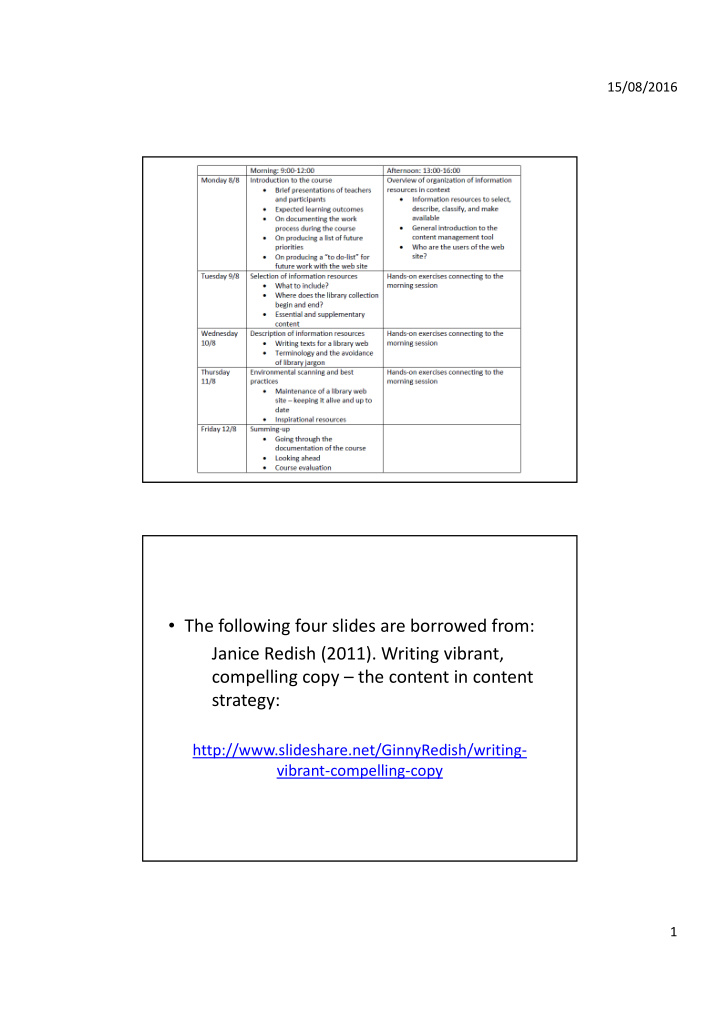



15/08/2016 • The following four slides are borrowed from: Janice Redish (2011). Writing vibrant, compelling copy – the content in content strategy: http://www.slideshare.net/GinnyRedish/writing ‐ vibrant ‐ compelling ‐ copy 1
15/08/2016 Why do people visit a website? • They want to… – Answer their questions(s) – Solve a problem – Do a task • Access content! • Navigation and search are critical • Good, clear design is critical • Technology that works is critical But… • They all support the content 2
15/08/2016 Content = everything • Text • Videos • Illustrations • Podcasts • Charts • Blogs • Graphs • Forums • Tables • Facebook • Forms LinkedIn • pdfs Twitter other social media Content strategy = Think strategically about your content • Planned • Coordinated Message • Managed Tone • Reviewed Style • Maintained • Removed 3
15/08/2016 Selecting material • Analyze user groups • Overview what is published/produced – both feebased and open access • Assess and evaluate material with reference to user group ‐ analysis • Make decisions regarding what to obtain – Informed by • Budget frames (freely available – fee ‐ based) • Acquisition policy (balance: digital ‐ printed) • Infrastructure for storage and archive 4
15/08/2016 5
15/08/2016 When writing for the web, using plain language allows users to find what • they need, understand what they have found, and then use it to meet their needs. It should also be actionable, findable, and shareable. People come to your website with a specific task in mind. When • developing your site’s content, keep your users’ tasks in mind and write to ensure you are helping them accomplish those tasks. If your website doesn’t help them complete that task, they’ll leave. People read differently online than they do when they read print materials • ‐‐ web users typically scan for information. In a study of online reading behavior Site exit disclaimer, Jakob Nielsen found that “on the average webpage, users have time to read at most 28% of the words during an average visit; 20% is more likely”. From: Writing for the Web, at usability.gov 6
15/08/2016 Writing style and tone From: Library Terms That Users Understand (2012) John Kupersmith 7
15/08/2016 • Task: – Find a university library website that you find attractive and good, present the website and explain why it is attractive and good. – Use the web – e.g. Google – to search for good library websites – For example: “academic library websites” or “best library websites” 8
15/08/2016 Horton, F.W. Jnr., & Keiser, B.E. (2008). Encouraging global information literacy. Computers in Libraries, 28 (10), 6 ‐ 7. Authors Year Article title Volume Issue Journal title Pages 9
15/08/2016 10
15/08/2016 11
15/08/2016 12
15/08/2016 13
15/08/2016 14
15/08/2016 15
! 15/08/2016 16
15/08/2016 • Classifying databases according to Topic, Type and College • Types – Identified types: • News content Reference Online lectures E ‐ books Tutorials Full ‐ text … • Topic • College • https://olapilerot.net/rwanda ‐ toolbox/ 17
15/08/2016 • “To do ‐ list” for future work with the web site: – Develop a proper controlled vocabulary for the database list – Make sure ALL databases are included in the list! – Join the Drupal group/community for libraries – Take as a habit to “constantly” scan the web for useful resources (e.g. free databases) that can be included in our list • Future priorities: – Create working groups with specific responsibilities, e.g. 1) controlled voc.; 2) “drupal experts”; 3) guidelines for language & presentation of the info. on the site; 4) Overview and structure of the site; 5) “day ‐ to ‐ day business”; 6) BEING CAREFUL! 18
Recommend
More recommend